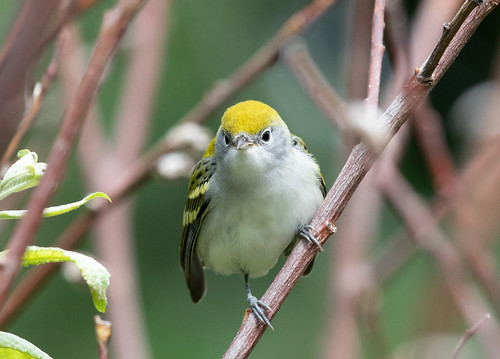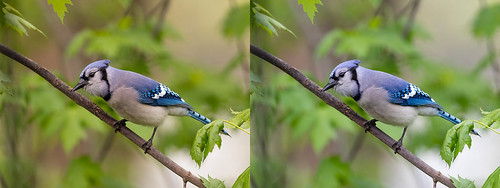 |
| On the right is how my right eye, with the new lens replacing my cataract-ridden lens, sees this photo. On the left is about how my left eye, which still has the cataract, sees it. |
I was pretty sure I had a good handle on color—I’ve always been able to appreciate the different shades of red in a Scarlet Tanager, Northern Cardinal, and Ruby-throated Hummingbird, and I love the lovely tropical greenish yellow of a Chestnut-sided Warbler in autumn and the subtle shades of pinks and purples in a Common Grackle in full sunlight.
 |
| This Common Grackle, sitting in perfect light, is showing off his iridescent colors. This is how he really looks, without any color adjustments. If he also displays some UV colors, we can't see them. |
Meanwhile, last week, the British Ecological Society published a paper by Cedric P. van den Berg, Jolyon Troscianko, John A. Endler, N. Justin Marshall, and Karen L. Cheney in Methods in Ecology and Evolution titled “Quantitative Colour Pattern Analysis: A comprehensive framework for the analysis of colour patterns in nature.” We humans and many primates are trichromatic, meaning we have three kinds of cones in our eyes—sensitive to red, blue, and green hues—that allow us to see colors along the ROYGBIV spectrum. Most mammals, including dogs and cats, are dichromatic with just blue and green-sensing cones in their eyes. Arctic reindeer have a special cone that detects the UV light that lichen emit.
Bees are trichromatic, but also pick up UV light. Many insects, fish, reptiles, and birds have four kinds of cones, and the mantis shrimp can have up to 16 kinds of cones. Color perception is important for such essential tasks as detecting prey animals or vegetation types, noticing predators, and signaling their own kind for competitive, mating, or flocking purposes.
To better understand the function of colour signals in nature, the researchers developed quantitative analytical frameworks to estimate how animal and plant color patterns appear against natural backgrounds as viewed by ecologically relevant species. The program they developed takes a photo of how we see something and adds brilliant colors to the areas outside our own visual spectrum.
Of course, what we can see in any photo is limited to colors within the wavelengths our human retinas can see, so this is just a visual representation to help our understanding, not at all the way animals actually see the world—our imaginations really are limited to the colors within our own spectrum. The photos they’ve produced are brilliantly wonderful, but the popular press picking up those photos are saying “This is how birds see the world,” and “This software shows you exactly how different animals view the world” when it isn’t. We have no idea what colors look like outside our own visual range, so although this wonderful work is important and cool, it simply does not show “how birds see the world.” Until we humans can evolve retinas with more kinds of cone cells, the colors birds and other animals see will ever remain a mystery to us mere humans.

